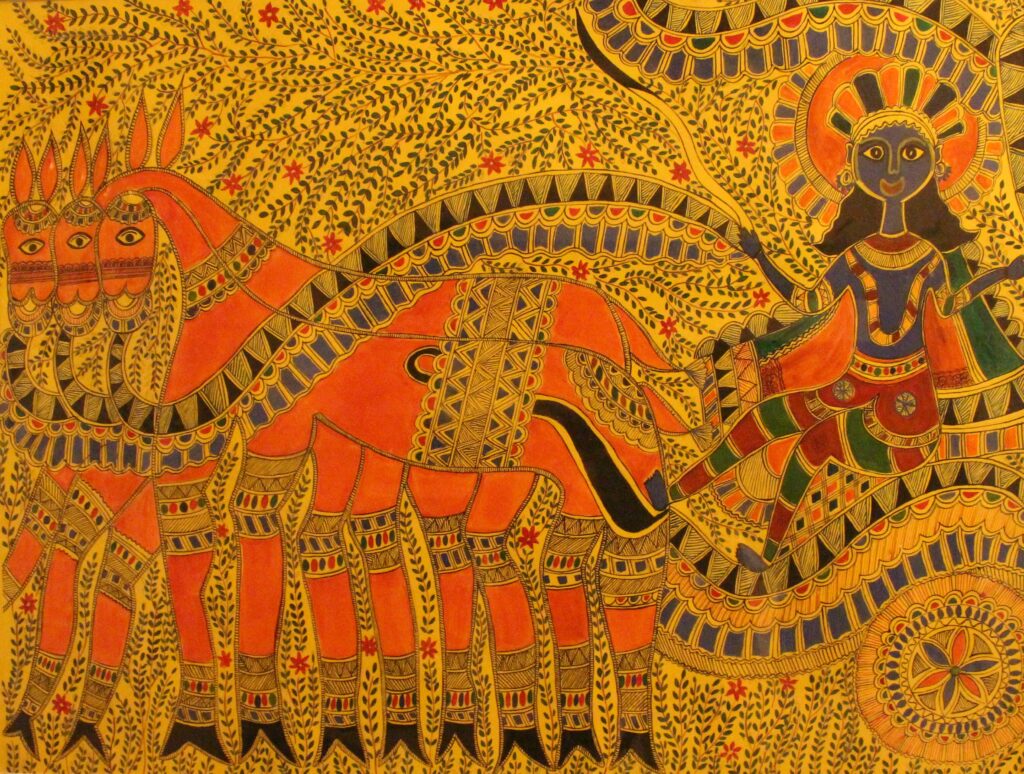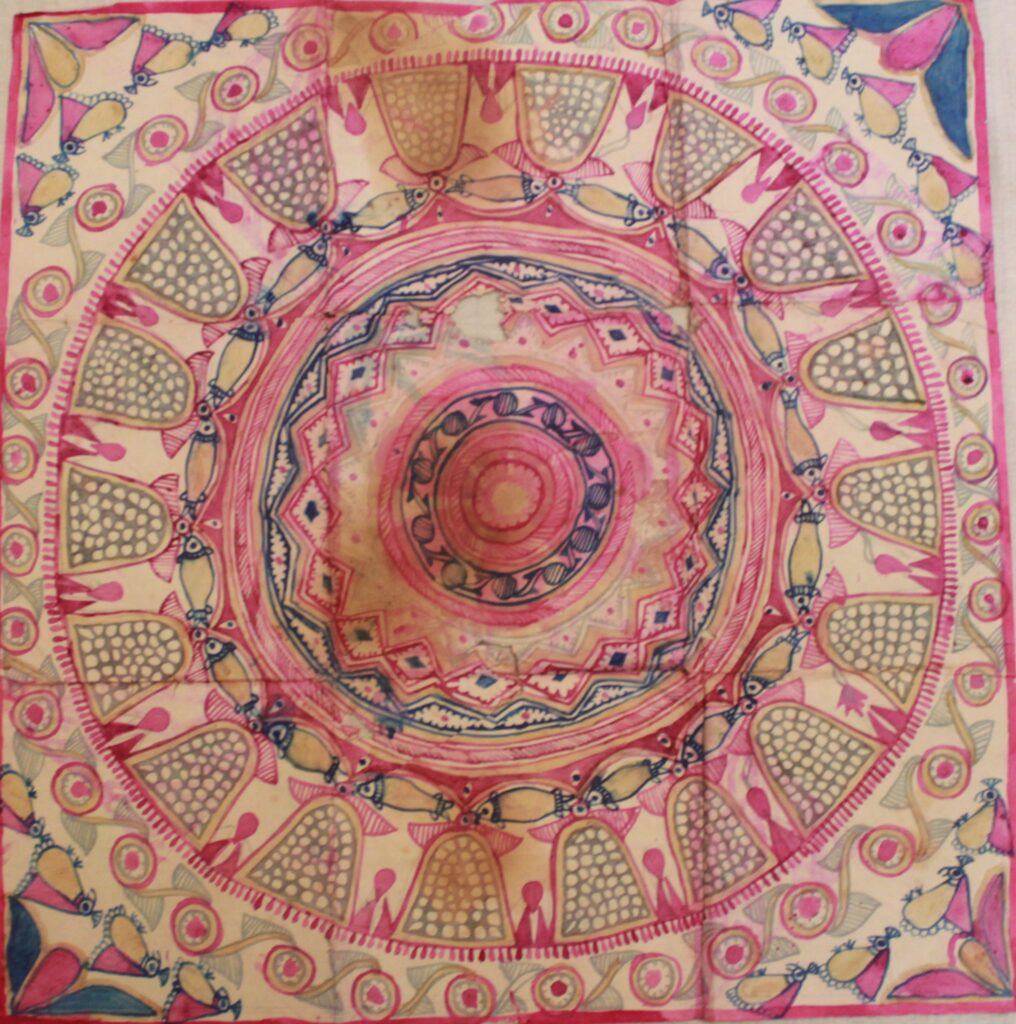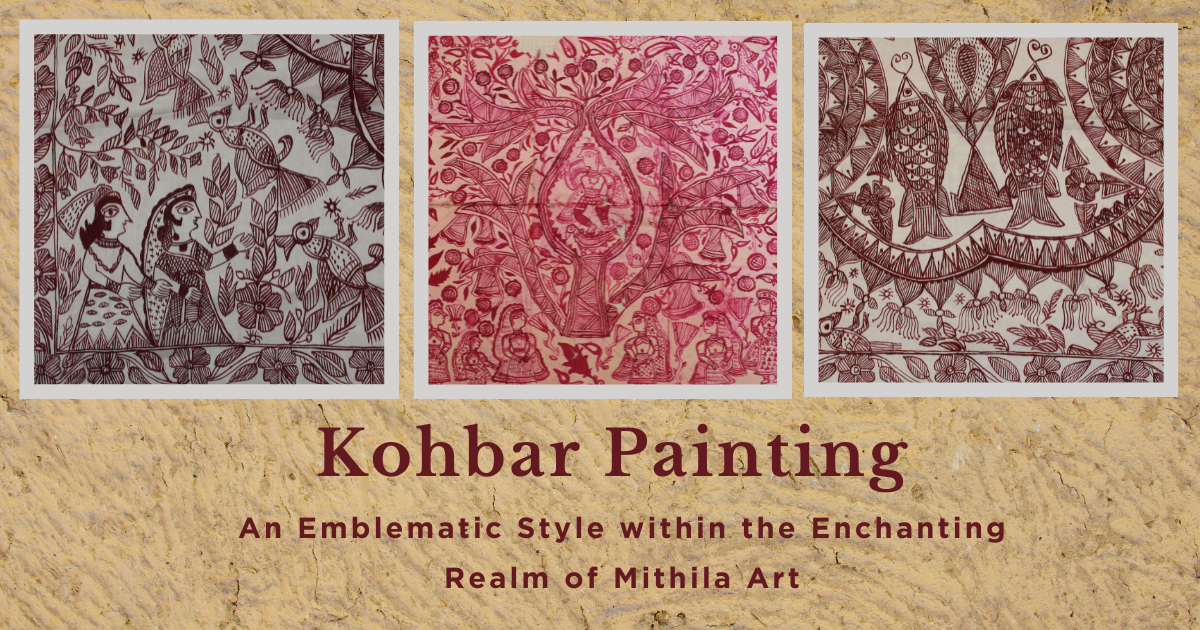Table of Contents
Introduction: Mithila Painting, A Vivid Art Form of India
India, a land of diverse cultural expressions, boasts a multitude of art forms that have withstood the test of time. One such enchanting art form is Mithila or Madhubani painting, originating as ritualistic wall art in the Mithila region of Bihar, India.

This captivating art style is renowned for its bold colors, intricate patterns, and vibrant motifs that narrate stories of mythology, folklore, and daily life. Madhubani art holds a sacred place in Indian heritage, and its evolution from traditional wall art to global recognition has been nothing short of awe-inspiring. In its origins, Madhubani paintings found their roots in various sects, resulting in the classification of five distinct styles: Tantrik, Kohbar, Bharni, Godna, and Katchni.
Each style brings a unique essence to this art form, enriching its heritage and captivating admirers with its intricate beauty.
Ancient Origins: Tracing the Roots of Mithila Painting
Mithila painting’s origins can be traced back to antiquity, and the art form finds mention in the ancient Indian epic, Ramayana.

Legend has it that when Lord Rama and Goddess Sita tied the celestial knot in Mithila, the locals rejoiced by decorating their homes with intricate paintings. Over time, these ritualistic wall paintings evolved into a distinct art form, depicting scenes from epics, folktales, and cultural celebrations
The Essence of Mithila Art: A Harmonious Confluence of Color and Spirituality
The heart of Mithila art lies in its profound connection to spirituality and culture. Created with a harmonious blend of vibrant colors and intricate patterns, these paintings serve as a medium for devotion and storytelling.


Artists, often local women, skillfully wield twigs, nibs, and natural pigments made from crushed flowers and leaves, breathing life into their art with each brushstroke.
Kohbar Painting: An Iconic Style within Mithila Art
Among the rich tapestry of Mithila art, Kohbar painting stands as a majestic jewel, revered for its significance in wedding rituals. The word “Kohbar” translates to “bridal chamber,” and these exquisite paintings were traditionally created to bless the newlywed couple and bestow prosperity upon them. Kohbar paintings vividly portray love, fertility, and joy, with every element holding symbolic meaning. During weddings, families would adorn the walls of the bridal chamber with Kohbar paintings, infusing the space with a sense of joy, prosperity, and blessings for the newlywed couple.
Kohbar painting stands at the centerstage of Mithila art, epitomizing the region’s cultural and artistic identity. Like other styles within Madhubani painting, Kohbar art employs the distinctive “line and color” technique. The masterful use of twigs, nibs, and natural pigments crafted from crushed flowers and leaves creates intricate detailing and rhythmic patterns, showcasing the skill and dedication of the artists.

The connection between Kohbar and Mithila art extends beyond technique, reflecting the seamless blend of culture, tradition, and artistic brilliance that make this art form an iconic representation of India’s artistic heritage.
Elements and Themes of Kohbar Painting
Kohbar paintings are resplendent with a plethora of symbols and themes, each carrying a profound significance.

The presence of gods and goddesses, such as Shiv-Parvati and Ram-Sita, symbolizes divine blessings upon the couple’s union. The tortoise, a symbol of longevity and stability, finds its place alongside the bamboo tree, representing resilience and growth and the kadam tree, signifying eternal love .
Lotus motifs symbolize purity and fertility, while fish depict abundance and prosperity in the household. The serpent god, often depicted in these paintings, signifies fertility and protection. The peacock, a symbol of eternal beauty and love, frequently graces the artwork, signifying the union of the bride and groom. The sun and moon, with their omnipresence, represent the eternal cycle of life and the passage of time.
The amalgamation of these elements forms a tapestry of blessings, guiding the newlyweds towards a prosperous and harmonious life together.
Local Women Artists: Nurturing the Tradition
Kohbar painting thrives through the skilled hands and unwavering dedication of local women artists in the Mithila region. Passed down through generations, these artisans infuse their art with a deep-rooted connection to their cultural heritage, preserving the essence of Mithila art for posterity. As custodians of this iconic art form, they contribute to its evolution and promotion, ensuring that the legacy of Kohbar painting remains alive and cherished.
Intricate Techniques: From Generation to Generation
The creation of Kohbar paintings is a labor of love, with techniques passed down through generations. Artists employ meticulous brushwork, using twigs and nibs to achieve the intricate patterns and detailing.


The use of natural pigments extracted from flowers and leaves imparts a unique vibrancy to the artwork. These age-old techniques, coupled with the artists’ creativity and innovation, breathe life into each painting, capturing the essence of celebration and joy.
Contemporary Expression: Kohbar Beyond the Bridal Chamber
While Kohbar painting’s roots lie in the sacred realm of marriage rituals, the art form has transcended its traditional boundaries to find expression beyond the bridal chamber. Contemporary artists have breathed new life into Kohbar painting, creating fusion pieces that blend tradition with modernity.

From exquisite canvases to elegant home decor, Kohbar’s legacy continues to evolve and captivate art enthusiasts worldwide.
Preserving a Cultural Heritage: Revival and Recognition
As Kohbar painting gains global recognition, efforts are being made to preserve and promote this artistic heritage.

Artisans and organizations collaborate to impart training and skill development, ensuring the art form’s continuity and passing it on to future generations. International exhibitions and art forums provide a platform for Kohbar artists to showcase their talent, fostering a renewed appreciation for this iconic style of Mithila art.
FAQs
1. How is Kohbar painting different from other styles of Madhubani art?
Kohbar painting is specifically associated with wedding rituals and is traditionally confined to the bridal chamber. It carries distinct motifs and symbols that celebrate love, fertility, and prosperity, setting it apart from other styles within Madhubani art.
2. What are the primary colors used in Kohbar painting?
Kohbar painting primarily utilizes vibrant hues made from natural pigments extracted from flowers and leaves. Colors like red, yellow, green, and blue are commonly used to create the intricate patterns and motifs.
3. Are there any specific rituals associated with creating Kohbar paintings?
Traditionally, Kohbar paintings were created as part of wedding rituals, adorning the walls of the bridal chamber to bless the newlyweds. The process of painting was considered auspicious and marked the beginning of the couple’s journey together.
4. Can anyone learn Kohbar painting, or is it passed down within families?
While Kohbar painting has been traditionally passed down through generations within families, anyone with a passion for art can learn the techniques and intricacies of this art form through workshops and training programs conducted by skilled artisans.
5. How can we support the preservation of Kohbar painting and Madhubani art?
Supporting local artisans, purchasing authentic Kohbar artworks, and encouraging initiatives that promote traditional art forms are effective ways to contribute to the preservation and recognition of Kohbar painting and Madhubani art as a whole.
6. What makes Kohbar painting an important cultural heritage of India?
Kohbar painting carries the legacy of ancient traditions, celebrating marriage rituals and prosperity. It symbolizes the confluence of art, spirituality, and cultural practices, making it a cherished and significant part of India’s artistic heritage.
Conclusion
Kohbar painting, an iconic style of Mithila or Madhubani art, stands as a majestic representation of India’s cultural heritage and artistic brilliance. Rooted in the sacred realm of marriage rituals, these vibrant and intricate artworks bless newlywed couples and bestow prosperity and happiness upon their lives. From the depiction of gods and goddesses to the symbolic presence of elements like the tortoise, bamboo tree, and serpent god, Kohbar art weaves together a narrative of blessings and auspiciousness. The seamless blend of tradition and innovation, coupled with meticulous techniques passed down through generations, breathes life into each painting, creating a legacy that transcends time and captivates art enthusiasts worldwide. As we celebrate the resplendent beauty of Kohbar painting, let us continue to preserve, promote, and recognize this iconic art form, ensuring that its brilliance shines on for generations to come.
